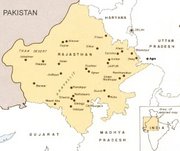Hi everyone!
We arrived here in Agra at around noon, after an early morning visit to the Keolaodeo Bird Sanctuary just outside Bharatpur. The sanctuary was simply amazing. They don't allow motorized vehicles, so we had to take cycle rickshaws to get into the interior of the park. The cycle rickshaw was an interesting experience; while the ride was certainly well ventilated, most of the drivers pedalling us (two at a time) seemed worn down. They do their work while dressed in full length pants and long-sleeved shirts in the hot and humid environment and get paid very little (around $1 US for a 5 km drive).
The park was full of all kinds of animals - we saw wild jackals, water buffalo, and a small herd of spotted deer in addition to many spectacular varieties of birds. Some of the interesting birds that we saw included an ibis, cranes, egrets, a bright red duck, buzzards and vultures, peacocks, and an adorable little snowy owlet watching us from up high on a tree trunk. Perhaps the most impressive bird that we saw was a black-necked stork, an endangered species of which there are only 30 nesting pairs in India. We also saw some giant turtles and some multicolored lizards, and, best of all, a HUGE monitor lizard sauntering across the road right in front of us. All in all, the visit was a refreshing change of pace after some busy cities, and seeing nature in India was a true pleasure.
After the bird sanctuary, we had breakfast and then headed back to our rooms for some relaxation before the (mercifully short) hour and a half drive to Agra. En route to the city, we stopped at Fatehpur Sikri, the one-time capital of northern India, now a complex of abandoned palace buildings on a small ridge over a dried-up lake. The palace was built by the Moghul emperor Akbar, considered the greatest Moghul leader in Indian history. As the story goes, Akbar moved from Agra to move his palace at Fatehpur Sikri because a holy man told him that he would be blessed with sons if he built there. While Muslim himself, as part of a conquering force, Akbar chose to have three wives, each of a different religious faith - Hindu, Muslim, and Christian. Each of the wives had their own separate quarters in the palace complex. The Muslim wife had stone carvings and inlaid tile decorating her walls and the Christian wife chose to have her walls covered with murals painted with gold, but the Hindu wife had an entire courtyard to herself. The courtyard had a Hindu temple and both a summer and a winter residence, each of which faced the best sunlight of the season. Interestingly, in the center of her elaborate courtyard was a simple small stone planter for holy basil, which is considered to have a multitude of medicinal and religious properties according to the tenets of Ayurvedic medicine. There was also a private meeting hall with an enormous central pillar carved in six different styles, one for each of the six main religions in India at the time. The carving was incredibly precise and was crafted out of a single piece of stone. The king sat at the top, which was reached by four carved elevated walkways, not unlike an architectural design one might see in Star Wars! Another interesting aspect of the palace was a life-sized parcheesi board inlaid into the stone of the main courtyard of the king's palace. The king and his favorite (Hindu) queen would sit on a raised platform in the center of the board and dictate the moves of the "pieces" - the king's concubines, who would dance from square to square as moves were called out.
Tomorrow we will rise at 5:15 am to see the Taj Mahal by the light of dawn. Our only glimpse so far has been from the revolving restaurant at the top of the hotel where we had dinner. Some of us are planning to wear our gorgeous new saris and salwar kamises for this special occasion (though the professors are trying to convince them that an Elmira College t-shirt is equally elegant).
More later,
Andrea and Martha
Subscribe to:
Post Comments (Atom)


No comments:
Post a Comment